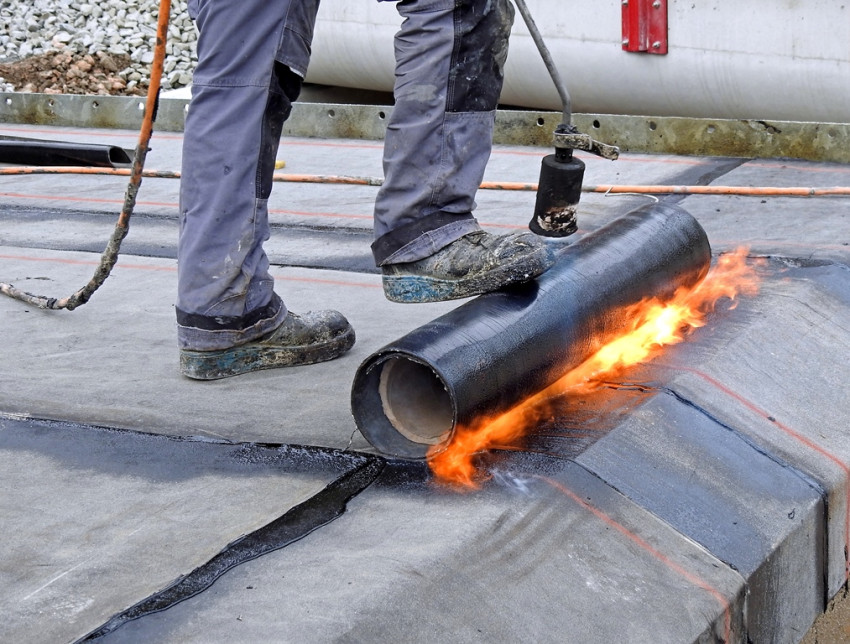
Companies to recycle bitumen from roofing
Three Dutch companies are going to recycle old roofing bitumen recovered during demolition work, and turn it into fresh bitumen for new roofs. They will be presenting their circular innovation 'citumen' (circular bitumen) this week at the Dutch Design Week in Eindhoven.
Reusing old bitumen from roofs for new roofing membranes means considerable savings in CO2 emissions, as new bitumen is made from crude oil, which releases carbon from the soil into the environment.
Citumen will not be particularly noticeable, because it looks exactly like the bitumen used to waterproof the flat roofs of homes. Large surfaces of bitumen roofing membranes are mainly used on office buildings.
ROOF COVERING
The innovation by New Horizon, Icopal and ZND Nedicom is not particularly complicated in terms of technology, as the technology of processing bitumen from demolished buildings into new roofing material already existed. About fifteen years ago, Icopal, one of the partners, tried to apply this technology, but was unsuccessful according to Cobouw.
Back then, it proved difficult to guarantee the quality of recycled bitumen, and builders also preferred new bitumen to reused material. Pricing also played a role as the price of oil, the raw material for making bitumen, was low at the time, so it was cheaper to buy raw materials than recover used bitumen.
ECONOMIC CONSIDERATIONS
Times have changed, however. The raw material used to make new bitumen is becoming increasingly scarce because oil companies are refining crude oil more and more efficiently (see box below). Together with Icopal, New Horizon now believes it can be profitable to recover bitumen from buildings. Bitumen producer Icopal needs a guaranteed supply of old bitumen for recycling, and New Horizon can supply it at a rate of 25,000 m2 of material per year. This guaranteed supply of material means efficiency gains and lower prices.
New Horizon also believes it will be able to ensure that the citumen finds its way to new buildings, thanks to the company’s extensive contacts in the property sector.
SAMPLE
Bitumen is recycled as follows. Before a building is demolished, New Horizon first takes a bitumen sample from the roof. A piece about the size of a sheet of A4 is cut out, and sent to Icopal’s lab where it is analysed. This indicates how many layers have been used, how thick they are, and the quality of the material.
‘This is also the stage where we find out what’s underneath the bitumen. So we can decide the best way of removing it. If it’s been placed directly on concrete, it can be scraped off mechanically. However, if there’s insulating foam underneath, more care is needed because you don’t want the foam in your bitumen,' says Michel Baars of New Horizon. In the latter case, it may be necessary to pull the bitumen from the roof manually.
The pieces of bitumen taken from the building are then passed through a shredder to make them smaller, before being sent on to Icopal in Groningen. Here, the material is melted into virgin bitumen in a large container. Any foreign objects or hard remnants are removed by a sieve, leaving the bitumen ready for processing into new roofing membranes.
SUNLIGHT
Bitumen that has been lying on a roof for many years is affected by UV radiation in sunlight. ‘That’s why, in the last step, additives are added to make the bitumen flexible and protect it against UV,’ says Caspar Ulijn, director of roofing company ZND Nedicom, on the phone. He estimates that bitumen can be reused seven or eight times using this technique.
ZND Nedicom is currently the only roofing company installing recycled bitumen on roofs. ‘However, I’m hoping that other companies will start using it eventually. I’ve got no intention of keeping it to myself, as there’s nothing I’d like more than to reuse the entire roof.'
CRUDE OIL
The citumen is not the first building industry product to be recycled by New Horizon. The company has already recycled concrete. It views old buildings as a source of useful materials, and specialises in methods for recovering these substances.
Many more initiatives in the field of circularity will be on display at the Dutch Design Week (20-28 October, in Eindhoven) under the heading Embassy of Circularity.
Bitumen is a product of crude oil refining. Bitumen is what remains after removal of the lighter fractions of naphtha, petrol and diesel. It is a semi-solid substance at room temperature, but becomes liquid when heated. Most of the bitumen from crude oil is used in asphalt roads, and only a small part for roofing – the application that New Horizon, Icopal and ZND Nedicom are focusing on.
If you found this article interesting, subscribe for free to our weekly newsletter!
Opening photo: a roofer covering a roof with a bitumen membrane roll. Photo: Wald1Siedel/CC BY-SA 4.0







